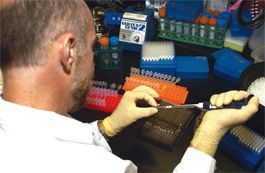Prescribing TKIs for the Treatment of CML
Pamela Crilley, DO, explains the benefits and downfalls of prescribing tyrosine kinase inhibitors for the treatment of CML.
Debu Tripathy, MD, Co-Leader, Women's Cancer Program, Norris Comprehensive Cancer Center, University of Southern California, discusses two important trials in breast cancer looking at extended hormonal therapy.
It is understood now that 10 years of tamoxifen is superior to 5 years in premenopausal patients with high-risk, early-stage disease. However, Tripathy says, most patients are postmenopausal and see benefit when treated with aromatase inhibitors. The question remains as to whether these patients could see benefit when treated with 10 years of an aromatase inhibitor compared to 5 years.
Clinical Pearls
While these results may not be the most scientifically interesting, Tripathy says, they will surely affect many patients.
- For patients who are premenopausal with high-risk, early-stage breast cancer, 10 years of tamoxifen has shown superiority to 5 years of tamoxifen
- In postmenopausal women, aromatase inhibitors have demonstrated superiority and a better side effect profile
- Two large studies look to answer the question as to whether extended use (10 years) of aromatase inhibitors will show benefit compared to 5 years
Myeloma
MM-003: A phase III, multicenter, randomized, open-label study of pomalidomide plus low-dose dexamethasone (LoDEX) versus high-dose dexamethasone (HiDEX) in relapsed/refractory multiple myeloma (RRMM)
Jesùs F. San-Miguel, MD, PhD
Breast Cancer
Pomalidomide + LoDEX significantly extended PFS and overall survival vs. HiDEX in patients who failed lenalidomide and bortezomib. Pomalidomide + LoDEX should become a standard of care in relapsed/refractory multiple myeloma patients who have exhausted treatment with lenalidomide and bortezomib.
PrECOG 0105: Final efficacy results from a phase II study of gemcitabine and carboplatin plus iniparib (BSI-201) as neoadjuvant therapy for triple-negative and BRCA1/2 mutation-associated breast cancer
Melinda L. Telli, MD
Preoperative gemcitabine and carboplatin plus iniparib is active in the treatment of early-stage triple-negative and BRCA1/2 mutation-associated breast cancer.
Gastrointestinal (Noncolorectal) Cancer
Results of a randomized phase III trial (MPACT) of weekly nab-paclitaxel plus gemcitabine versus gemcitabine alone for patients with metastatic adenocarcinoma of the pancreas with PET and CA19-9 correlates
Daniel D. Von Hoff, MD
Developmental Therapeutics - Immunotherapy
MPACT was a large, international study performed at community and academic centers. nab-paclitaxel + gemcitabine was superior to gemcitabine across all efficacy endpoints, had an acceptable toxicity profile, and is a new standard for the treatment of metastatic PC that could become the backbone for new regimens.
A study of MPDL3280A, an engineered PD-L1 antibody in patients with locally advanced or metastatic tumors
Roy S. Herbst, MD, PhD
MPDL3280A was well tolerated, with no pneumonitis-related deaths. Durable responses were observed in a variety of tumors. PD-L1 tumor status appears to correlate with responses to MPDL3280A.
Nivolumab (anti-PD-1; BMS-936558; ONO-4538) in patients with advanced solid tumors: Survival and long-term safety in a phase I trial.
Suzanne L. Topalian, MD
Nivolumab produced sustained survival with a manageable long-term safety profile in advanced melanoma, NSCLC and renal cell carcinoma, supporting its ongoing clinical development in controlled phase III trials with survival endpoints.
A phase II study of NPC-1C: A novel therapeutic monoclonal antibody (mab) to treat pancreatic and colorectal cancers
Preliminary results with NPC-1C show signs of clinical activity based on stable disease in heavily pretreated patients with pancreating and colorectal cancer. Safety has been established at the 1.5 mg/kg dose. A new lot of NPC-1C, produced with improved sterility and purification procedures and demonstrating no red cell agglutination, has been manufactured under GMP conditions. We plan to introduce this new lot at the current 1.5 mg/kg dose level. If there are no dose limiting toxicities, we plan to dose escalate to a higher MTD at which we will re-evaluate clinical efficacy.
Lung Cancer
A phase III study of pemetrexed (Pem) plus carboplatin (Cb) plus bevacizumab (Bev) followed by maintenance pem plus bev versus paclitaxel (Pac) plus cb plus bev followed by maintenance bev in stage IIIb or IV nonsquamous non-small cell lung cancer (NS-NSCLC): Overall and age group results
Mark A. Socinski, MD
Overall survival was not significantly different in any of the age subgroups. PFS was significantly longer in pemetrexed arm overall and for patients ≤70, but was similar for patients >70, >75 yrs. Toxicity profiles differed; subgroup safety data paralleled overall data.
Clinical activity, safety, and biomarkers of MPDL3280A, an engineered PD-L1 antibody in patients with locally advanced or metastatic non-small cell lung cancer (NSCLC)
David R. Spigel, MD
Treatment with MPDL3280A was well tolerated, with no pneumonitis-related deaths. Rapid and durable responses were observed. PD-L1 tumor status correlated with response to MPDL3280A.
Prostate Cancer
CA184-095: A randomized, double-blind, phase III trial to compare the efficacy of ipilimumab versus placebo in asymptomatic or minimally symptomatic patients with metastatic chemotherapy-naive castration-resistant prostate cancer
The primary endpoint is overall survival; secondary endpoints include progression-free survival, time to pain progression, time to non-hormonal systemic therapy and safety characterization. The accrual goal is 600 patients randomized.
Outcomes in patients with liver or lung metastatic castration-resistant prostate cancer treated with the androgen receptor inhibitor enzalutamide: Results from the phase III AFFIRM trial.
In the phase III AFFIRM trial, patients with lung mCRPC had higher median overall survival than patients with liver mCRPC. Enzalutamide resulted in higher response rates in both liver and lung mCRPC patients. Overall survival and radiographic progression-free survival were also improved in both patient groups treated with enzalutamide.
Design of the AFFINITY study: A randomized phase III study of a novel clusterin inhibitor, custirsen, plus cabazitaxel/prednisone (CbzP) versus CbzP alone as second-line chemotherapy in metastatic castration-resistant prostate cancer (mCRPC)
Genitourinary (Nonprostate) Cancer
The primary efficacy measure is overall survival. The secondary measure is proportion of patients alive without disease progression at Day 140 post-randomization.
Rates of dose adjustment in patients treated with tivozanib versus sorafenib in the phase III TIVO-1 study.
Lower rates of dose adjustment due to related AEs were observed in patients with metastatic RCC who received tivozanib compared to sorafenib
Phase III randomized sequential open-label study to evaluate the efficacy and safety of sorafenib followed by pazopanib versus pazopanib followed by sorafenib in the treatment of advanced/metastatic renal cell carcinoma (SWITCH-2 study).
The primary endpoint of this study is to evaluate if total PFS of sorafenib followed by pazopanib is non-inferior to pazopanib followed by sorafenib.
A phase III comparative study of nivolumab (anti-PD-1; BMS-936558; ONO-4538) versus everolimus in patients with advanced or metastatic renal cell carcinoma previously treated with antiangiogenic therapy.
The primary endpoint is overall survival. Secondary endpoints include PFS, ORR, OR duration, adverse events, overall survival in PD-L1 positive or negative subgroups, and patient-reported outcomes. The trial is open and enrolling patients.
Gynecologic Cancer
A randomized double-blind phase III trial comparing vintafolide plus pegylated liposomal doxorubicin (PLD) versus PLD plus placebo in patients with platinum-resistant ovarian cancer (PROCEED).
The primary objective is to assess PFS based on investigator assessment (RECIST v1.1) in folate receptor positive patients. Secondary objectives include overall survival, safety/tolerability, overall response rate, and disease control rate. Enrollment to the study is currently ongoing.
Exploratory analysis of nibrin in advanced ovarian cancer (AOC) patients treated in the phase III OVA-301 trial.
The results point out the potential importance of nibrin expression in the clinical outcome of patients with advanced ovarian cancer. In particular, high protein expression of nibrin seems to be associated with a worse clinical outcome. Prospective clinical trials evaluating the clinical usefulness of this marker with other standard of care treatments are warranted.
<<<
View all coverage from the 2013 ASCO Meeting
Darrin Stuart, PhD, senior research investigator at the Novartis Institutes for Biomedical Research in Emeryville, California

Darrin Stuart, PhD
Results of a preliminary study presented at AACR 2013 suggest that using an intermittent dosing strategy with vemurafenib instead of continuous dosing has the potential to overcome the development of resistance in patients with melanoma treated with the drug.
“When vemurafenib was introduced, it was exciting to witness the translation of the discovery of BRAF mutations in melanoma into an effective therapy. However, it was disappointing to see patients stop responding to such a promising therapy after 6 to 8 months of treatment,” said Darrin Stuart, PhD, senior research investigator at the Novartis Institutes for Biomedical Research in Emeryville, California.
BRAF mutations occur in more than 50% of melanoma patients, and vemurafenib extends survival for these patients. However, most of these patients will relapse with lethal drugresistant disease, Stuart said.
A previous study by Stuart and colleagues found that xenografts of melanoma tumors expressing BRAF mutations implanted in experimental mouse models developed resistance to vemurafenib; moreover, the tumors exhibited dependence on vemurafenib to sustain their growth. When the drug was stopped, tumor growth was suspended, and some tumors regressed in the mouse model.
Stuart and colleagues sought to determine whether the tumor drug dependency observed in experimental animal models was also present in humans. They studied 42 patients with vemurafenibresistant tumors. CT scans were available for 19 of these patients who were taken off treatment; 14 of the 19 demonstrated a decrease in the rate of tumor growth once they were no longer taking vemurafenib.
“This is the first evidence that the drug-addicted state that we observed in mouse models may also occur in humans,” he said.
The next step was to implant xenografts of patient-derived BRAF-positive tumors in mice and treat them with vemurafenib either on an intermittent schedule of 4 weeks on/4 weeks off, or on continuous treatment. None of the animals in the intermittent dosing group developed drug resistance.
Continuous dosing maintained the selective pressure required for the few surviving tumor cells to develop resistance, and alternating the selective pressure through intermittent dosing appeared to prevent the evolution and expansion of resistant cells, Stuart said.
At a press conference, Stuart was asked whether the next step for Novartis will be to study intermittent dosing and compare it with continuous dosing in patients. “Novartis is interested in testing multiple approaches that include trying different dosing regimens to using different combinations of drugs with vemurafenib,” he said. “I am not at liberty to say what the company is planning, but I can say we are enthusiastic about the findings I reported at this meeting. Patients derive a clinical benefit from vemurafenib and then develop resistance. Some sort of drug holiday makes sense. I hope people will study this clinically.”
Reference
Thakur MD, Fisher R, Salangsang F, et al. Modeling vemurafenib resistance in melanoma reveals a strategy to forestall drug resistance. Presented at: the AACR Annual Meeting 2013; April 6-10, 2013; Washington, DC. Abstract LB-144.
Tumor tissue samples

Tumor tissue samples await analysis for cancer-related genes at the Center for Advanced Molecular Diagnostics at Brigham and Women’s Hospital in Boston.
As the cost of sequencing and analyzing genetic data continues to fall, the nation’s leading cancer centers keep unveiling ambitious new clinical programs and research projects that will change the way every cancer specialist practices. Dana-Farber Cancer Institute, along with Brigham and Women’s Hospital, has launched one of the biggest research programs to date, in which the Boston, Massachusetts, centers seek to make the tumors of every patient with cancer a subject of genetic research.
Other cancer centers, while not broadening the research pool so widely, have deepened it by analyzing multiple tumor samples from each patient or conducting full-genome sequencing of both tumor samples and healthy tissue in tested patients.
These research projects supplement rapidly evolving protocols for clinical care. The tumors of most patients at most major facilities now receive some form of genomic testing to guide treatment. And that testing keeps getting more detailed.
For oncologists, hematologists, and other specialists who treat patients with cancer outside academe, these trends portend more than just an avalanche of studies that will have to be read. They portend a whole new age, albeit one that’s still a bit hazy.
Gordon B. Mills, MD, PhD

Gordon B. Mills, MD, PhD
“Genetic analysis has already changed cancer care at every practice, and we’ve only seen the tiniest tip of the iceberg,” said Gordon B. Mills, MD, PhD, who chairs the Department of Systems Biology and holds the Olga Keith Weiss Distinguished University Chair for Cancer Research at The University of Texas MD Anderson Cancer Center in Houston.
“But I think we have a little work to do before we know how we can best use these new tools,” he said. “Different cancer centers are trying different things, which will help us figure out what works and what doesn’t, and what all cancer specialists should eventually be doing.”
Sequencing Costs Plummeting
Ever since the Human Genome Project resulted in the full sequencing of the first human genome in 2003, technological advances have increasingly enabled researchers to explore the genetic underpinnings of cancer at a decreasing cost.
“The ability to sequence an individual’s entire genome as well as the patient’s tumor genome is now a feasible enterprise at a cost and speed that was unthinkable even five years ago,” noted Boris Pasche, MD, PhD, of the University of Alabama in Birmingham, and Devin Absher, PhD, of the HudsonAlpha Institute for Biotechnology in Alabama, in an editorial in the Journal of the American Medical Association last year.1
Indeed, it took 10 years and more than $2 billion to sequence the first human genome. Today, whole-genome sequencing costs from approximately $10,000 to $35,000 per human genome, and the National Institutes of Health (NIH) $1000 genome target is within the realm of possibility.2Meanwhile, the nation’s network of cancer centers has been gearing up to make the most of the new technology, both individually and with federal leadership. After the genomic changes that occur in gliobastoma and ovarian cancers were successfully mapped, the NIH launched The Cancer Genome Atlas project in 2009. More than two dozen institutions throughout the country are working on characterizing, sequencing, and analyzing the genomes of more than 20 cancers.3
As part of that effort, the University of California, Santa Cruz, has established the Cancer Genomics Hub, intended to serve as a repository and portal for an anticipated deluge of data. Research for the atlas currently generates about 10 terabytes of data each monthfar more than the 45 terabytes of data the Hubble Space Telescope gathered in its first 20 years, according to a press release announcing the first supercomputer milestone in May.4
A researcher at the National Human Genome Research Institute uses a pipette to prepare DNA for sequencing.

A researcher at the National Human Genome Research Institute uses a pipette to prepare DNA for sequencing.
Research Reveals Complexities
Amid this bounty of information, those in the forefront of such research are striking notes of caution about how quickly genomic knowledge can translate into clinical advances.
Much of the uncertainty stems from continuing discoveries about cancer’s true complexity. Mills’ colleagues at MD Anderson, for example, recently made a particularly dispiriting discovery that has already transformed cancer care at MD Anderson and other hospitals.
Cancer, they found, mutates so quickly that metastasized tumors often vary genetically from and within primary tumors. In some cases, tumor genes can vary by 40%. Even a single large tumor can vary genetically from one side to another, an unnerving fact in an age when tests of tumor genes taken from a single biopsy are supposed to tell doctors the proper course of treatment, Mills noted.
MD Anderson has responded by performing genetic testing on several different tumor samples from patients with cancers that are likely to mutate. If the tests show several different strains of cancer, the hospital responds by treating them all. Even so, in those tumor types that MD Anderson has studied, changes between the primary tumor and the metastases correlate strongly with bad outcomes, so the cen-ter is working to develop new treatment strategies.
“The discovery of these tumor mutations should be a big step forward in making good treatment decisionsa real advance that doctors everywhere should be thinking about—but it will probably delay efforts to do full genome analysis on every patient and every tumor,” Mills said.
“Not only will there be the extra cost of full sequencing for a handful of samples from every patient, the extra data add astronomical complexity to the analysis of what all those genes do,” he said.
Technology Terms in Cancer Genomics
The following institutions are the major research centers participating in the TCGA. The project is scheduled to receive $175 million through the American Recovery and Reinvestment Act and $50 million each from the National Cancer Institute (NCI) and the National Human Genome Research Institute.
Term
Description
Whole-Genome Sequencing
Consists of 3 phases: sample preparation, where genome target is broken into fragments; physical sequencing, where bases in each fragment are identified in order; and reconstruction, where bioinformatics software is used to align overlapping reads from each fragment.
Targeted Genome Sequencing
Refers to strategies that enrich the input for DNA regions such as whole exome or cancer genome.
Cancer Genotyping
Involves use of multiplex assays and microarrays to analyze hundreds to millions of germline, somatic mutations, gene copy number variations, and other alterations affecting gene expression. Detects only known variants that have been selected for analysis.
Bioinformatics
Applies statistics and computer science to biology through information management and algorithm development.
J Clin Oncol
Tran B, Dancey JE, Kamel-Reid S, et al. Cancer genomics: technology, discovery, and translation [published online ahead of print January 23, 2012].. 2012;30(6):647-660. doi:10.1200/JCO.2011.39.2316.
Project Focuses on Full Genome
Nevertheless, at least one institution is moving ahead with full genome analysis, not with all patients, but in at least one large research study.
Doctors at the Mayo Clinic in Rochester, Minnesota, have initiated the Breast Cancer Genome Guided Therapy Study (BEAUTY) for 200 women with locally advanced breast cancer. The goals: to discover why some women do not respond fully to neoadjuvant chemotherapy and to speed the development of treatments targeted to nonresponders.
Researchers will perform full genome analysis not only on every woman’s tumor, but also on a healthy blood sample from each participant. The information from the normal or germline sample should help illustrate which human genes lead to what tumor genes, and whether variations in patients’ DNA lead to varying responses to treatment, even when tumor genes are similar.
All tumor samples will be kept alive and grown inside mice, so that fully sequenced live human tumors will be forever available for research and testing.
Matthew P. Goetz, MD

Matthew P. Goetz, MD
“The ultimate goal here is to speed drug development by determining which genetic variations determine who responds to a given treatment, and to develop novel therapies for women whose tumors are resistant to standard chemotherapy. Currently, every woman receives a standard course of treatment, and it fails to completely eradicate tumors in a substantial number of patients,” said Matthew P. Goetz, MD, associate professor of Oncology and Pharmacology, at Mayo’s College of Medicine.
“Preserving the human tumor as mouse xenografts will provide the ability for us to partner with pharmaceutical companies in order to test new drugs, with the focus being on those tumors not eradicated with standard chemotherapy. These are fully human tumors but because they’re preserved as xenografts, you can experiment with treatments in a way you obviously cannot when humans are involved.”
Actually, the ultimate goal is far more ambitious than identifying relevant genetic variations and developing new drugs for this one form of cancer.
Judy C. Boughey, MD

Judy C. Boughey, MD
“This is a flagship study at Mayo. If successful, we would plan to replicate this approach for different types of cancer,” said Judy C. Boughey, MD, associate professor of Surgery at Mayo’s College of Medicine. “Multiple other solid organ tumors, such as lung or pancreas, would be appropriate for similar studies.”
Taking a Look at Many Tumors
Unlike Mayo’s study, which will provide extraordinarily deep information about 200 women and 200 tumors, the flag-ship genomics effort at Dana-Farber will only provide a few hundred data points on every tumor examined. But Profile, as the program is called, will provide that detail on the overwhelming majority of patients at the hospitalan estimated 10,000 new cases of cancer per year.Every patient who walks in the door at Dana-Farber and at Brigham and Women’s is asked to participate and, to date, about 70% of them have agreed, said chief scientific officer Barrett J. Rollins, MD, PhD, who is one of the architects of the program and is the Linde Family Professor of Medicine at Harvard Medical School.
Barrett J. Rollins, MD, PhD

Barrett J. Rollins, MD, PhD
Participation requires no extra biopsies or other procedures. Researchers simply perform extra tests on the tumor samples they naturally take.
Investigators also are analyzing the archived tumor samples of patients who give consent. In theory, they could go back decades because the hospital stores samples indefinitely, but financial considerations have stopped the team from going back further than two years.
The analysis, for both new and pre-existing patient samples, is similar. Rather than looking for the handful of genetic variations that are understood well enough to influence treatment of any particular cancer, the lab examines 471 alleles of 41 genes suspected of playing some role in cancer.
All of that information goes into a massive database, where sophisticated software will look for relationships between tumor genes, disease progress, and response to treatment.
This automated data mining constitutes just one of several major uses for all of the information that is collected.
Investigators will also have access to the data, stripped of any information that identifies the patient. Researchers who become curious about how a certain genetic variation affects the course of a particular cancer will be able to simply look it up in the Profile database, rather than have to set up a study to collect the information from scratcha process that Rollins said is often the most costly and time-consuming aspect of a particular study.
The Cancer Genome Atlas (TCGA) Research Network
The following institutions are the major research centers participating in the TCGA. The project is scheduled to receive $175 million through the American Recovery and Reinvestment Act and $50 million each from the National Cancer Institute (NCI) and the National Human Genome Research Institute.
Center Specialization
Institution
Biospecimen Core Resources
International Genomics Consortium, Phoenix, AZ
The Research Institute at Nationwide Children’s Hospital, Columbus, OH
Genome Characterization Centers
Baylor College of Medicine, Houston, TX
Brigham & Women’s Hospital and Harvard Medical School, Boston, MA
British Columbia Cancer Agency, Vancouver, Canada Broad Institute, Cambridge, MA
University of North Carolina, Chapel Hill, NC
University of Southern California, Los Angeles
Johns Hopkins University, Baltimore, MD
Genome Sequencing Centers
Baylor College of Medicine, Houston, TX
Broad Institute, Cambridge, MA
Washington University School of Medicine, St. Louis, MO
Genome Data Analysis Centers
Broad Institute, Cambridge, MA
Institute for Systems Biology, Seattle, WA
Lawrence Berkeley National Laboratory, Berkeley, CA
Memorial Sloan-Kettering Cancer Center, New York, NY
University of California, Santa Cruz, Santa Cruz, CA
University of North Carolina at Chapel Hill, Chapel Hill, NC
University of Texas MD Anderson Cancer Center, Houston, TX
Data Coordinating Center
NCI Center for Bioinformatics, Bethesda, MD
Quick facts. The Cancer Genome Atlas website. http://cancergenome.nih.gov/newsevents/ forthemedia/quickfacts. Accessed May 7, 2012.
Perhaps more importantly, organizations that want to test drugs on people who have rare combinations of genes and tumors will be able to find a large group of potential patients, already identified, rather than having to find a full cohort of patients by themselves. This step alone could cut development times by years for some drugs.“Even analyzing 10,000 tumors a year, it’s going to take several years for this study to bear fruit, but there are enormous advantages to a study with these numbers. Many relationships are impossible to see in individual patients or dozens of patients or even hundreds of patients, but they will emerge clearly when you’re studying tens of thousands of patients,” said Rollins.
“Such a project would have been impossible even a couple years ago, but the cost of sequencing genetic samples has fallen so rapidly and the computing power available to analyze the data has gotten so fast, that we can finally do this,” he said. “At some point, every doctor’s office may be participating in studies like this.”
Rollins said the cost per patient for the 471-allele test has already fallen to just $500, and it continues to fall so quickly that Dana-Farber may soon sequence whole exons rather than just the alleles. Still, even with costs falling so fast, the Profile team is looking hard for financing, either research money from outside sources or data that translate some of their efforts from research to treatment and allows them to charge insurers.
Treading Cautiously to the Clinic
But the jump from pure research to improved treatment will be a cautious one, no matter how fast the computers start spotting fascinating correlations. “We won’t be changing treatment protocols based directly on correlations we find with Profile. We think that such a massive observational study will give us countless ideas to test, but observations can never take the place of controlled tests, no matter how compelling they look,” Rollins said. “Aside from those patients who end up in clinical trials because their records are in our database, participation in Profile probably will not end up changing what care patients receive.”
Rollins believes that the 70% participation ratefor a research project that probably won’t benefit patients who en-roll—demonstrates how far the medical profession has come in convincing patients of both the importance of genetic research and the efficacy of privacy safeguards. Patients are rapidly becoming more comfortable with the underlying issues.
Looking forward, moving beyond single-hospital initiatives like Profile to ones that collect patient data from several, and eventually most, facilities will likely take some time.
Not only would such studies require even greater technology, they’d also need enormous amounts of coordination (and, given the fact that many doctors have yet to switch to electronic records, probably persuasion), either from the government or some industry group, experts said. Most powerhouse cancer centers say they’re still at least a year or two away from trying a single-building effort like Profile, observers said. Some even believe it may be too early for even limited genetic testing on all cancer patients.
“At Vanderbilt, we are taking a disease-specific approach, with the goal of trying to build a sustainable model for mutational profiling,” said William Pao, MD, PhD, director of Personalized Cancer Medicine at Vanderbilt University Medical Center in Nashville, Tennessee.
William Pao, MD, PhD

William Pao, MD, PhD
The Cancer Genome Atlas (TCGA) Research Network includes three large-scale sequencing centers.

The Cancer Genome Atlas (TCGA) Research Network includes three large-scale sequencing centers.
Unlike many cancer centers that are trying to perform some genetic analysis as part of clinical care for all cancer patients, Vanderbilt currently has routine screens for three tumor types: lung, breast, and melanoma. They expect to add systematic colon cancer screens later this year, and other tumor types can be profiled by request.
Pao believes that the genetic makeup of individual tumors should be considered to help prioritize treatment for all oncology patients. In order to help facilitate an informed approach to cancer medicine and to identify appropriate genotype-driven clinical trials for patients, he and his colleagues have developed an online tool, MyCancerGenome (www.mycancergenome.org), freely available to all.
“We’ve worked with colleagues around the world to build a knowledge base about tumor mutations and how they affect cancer responses to targeted therapies. We put all the information online in a way that’s easy for every doctor to access, to understand and, when appropriate, to act upon,” said Pao, speaking of MyCancerGenome.org. “All this research needs to be accessible or doctors won’t be able to take full advantage of it.”
References
JAMA
- Pasche B, Absher D. Whole-genome sequencing a step closer to personalized medicine [editorial].. 2011;305(15):1596-1597.
J Clin Oncol
- Tran B, Dancey JE, Kamel-Reid S, et al. Cancer genomics: technology, discovery, and translation [published online ahead of print January 23, 2012].J Clin Oncol. 2012;30(6):647-660. doi:10.1200/JCO.2011.39.2316. [Erratum:. 2012;30(10):1149].
- Quick facts. The Cancer Genome Atlas website. http://cancergenome.nih.gov/newsevents/forthemedia/quickfacts. Accessed August 22, 2012.
- Stephens T. UC Santa Cruz builds national data center for cancer genome research [news release]. Santa Cruz, CA: University of California Santa Cruz Public Information Office; May 1, 2012. http://news.ucsc.edu/2012/05/cancer-genomics.html. Accessed August 22, 2012.
Pamela Crilley, DO, medical oncologist, Cancer Treatment Centers of America, Eastern Regional Medical Center, explains the benefits and downfalls of prescribing TKIs for the treatment of CML.
Clinical Pearls
While a TKI is less invasive than a bone marrow transplant, the toxicity of TKIs remains a factor, especially considering the length of time a patient must be treated. Research is being conducted to analyze the outcome of CML patients based on the rapidity of which they reach milestones.
- TKI treatment is less invasive than a bone marrow transplant but still has downfalls
- CML is a chronic disease and TKI treatment must be consistent and long
- The toxicity of a TKI affects a patient's and physician's decision
- Research is being conducted to analyze the rapidity of which patients reach milestones in the treatment of CML